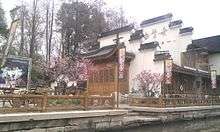Qinhuai River
| Qinhuai River | |
|---|---|
|
| |
| Native name | 秦淮河 |
| Country | China |
| Region | Nanjing, Jiangsu Province |
| Physical characteristics | |
| Length | 110 km |
| Basin features | |
| Basin size | 2630 km2 |
The Qinhuai River (秦淮河) is a tributary of the Yangtze with a total length of 110 km. It flows through central Nanjing and is called "Nanjing's mother river". It is the "life blood" of the city. The Qinhuai River is divided into inner and outer rivers.
Yesterday, the scenic belt along the Qinhuai River develops with the Confucius Temple at the center and the river serving as a bond. The belt, featuring attractions such as Zhanyuan Garden, the Confucius Temple, Egret Islet, China Gate as well as the sailing boats in the river and pavilions and towers on the riverbanks, is a blend of historic sites, gardens, barges, streets, pavilions, towers, folk culture and customs.[1]
History


The Qinhuai, a branch of the mighty Yangtze River has nursed the rich civilization of the region. The inner river of the river once was the red-light district famous throughout the nation in the Ming and Qing dynasties. Painted boats with red lanterns once shuttled to and from, heavily made-up, gifted alms all became historical things. A busy colorful bazaar has gradually taken shape here. Now the flourishing riverside area can be compared to the Nanjing Road of Shanghai and some do call it the "Mini Nanjing Road". Small shops, stores, restaurants and bars cluster the area. One can find everything here ranging from colorful trinkets to local specialties. At night the whole area is lit up with colorful lights thus creating a very impressive scene. A lively street market is set up in the area and both locals and tourists take part in the bargain hunt. Taking a leisurely stroll along the riverside, seeing the Chinese vendors doing their business or boarding colorfully decorated boats on the ancient river could be a memorable experience.
The most prominent part of Qinhuai River Scenic area in history is famous as a residential area of Qin Huai Ba Yan (秦淮八艳, Eight Beauties of Qinhuai), eight famous courtesans during the Ming-Qing transition period. They were recorded in the book Banqiao Zaji (板桥杂记) by Yu Huai (余怀). They were Gu Hengbo (顾横波), Dong Xiaowan, Bian Yujing (卞玉京), Li Xiangjun, Kou Baimen (寇白门), Ma Xianglan, Liu Rushi and Chen Yuanyuan.
During the Nanjing Massacre in 1937, Qinhai River was filled with tens of thousands of bodies, and was reddened with blood. Many Chinese folk songs about the massacre have details about the river at that time.
Sightseeing
This place is very popular with the locals and many see or buy their items here, or they just hang out around the area. Many foreigners find it a good place to taste the local cuisine. The many snack stalls dotted within the area offer a range of food: (baozi) steamed buns-stuffed with pork, and other delicate fillings, Bawei Dawei Doufunao (eight-flavored jellied bean curd pastries) roasted beef, salty duck, animal stomach, chicken feet (phoenix feet) and much more.
The former residence of famed courtesan Li Xiangjun is located along the Qinhuai River and is open to the public.[2]
References
- ↑ Life on the Water's Edge: The Culture and History of the Qinhuai River - China.org.cn
- ↑ Zhang 张, Weiya 维亚 (2007). "文学旅游地的遗产保护与开发——南京夫子庙李香君故居和王谢古居案例研究" [On the Heritage Protection and Development of Literary Tourism Destinations —— Taking Li Xiangjun Former Residence and Wang Xie Ancient House in Nanjing Confucius Temple as A Case]. Luyou Xuekan (in Chinese) (3): 40–44.
Coordinates: 32°04′40″N 118°43′33″E / 32.07778°N 118.72583°E